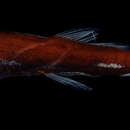en
names in breadcrumbs


View data on Catalog of Fishes here.
Vertebrae 29–31 [30–31] + 15–16 =45–46 [44–46]. Maximum body depth 5.6–6.7 times in SL. Caudal peduncle depth 2.4–2.9 times in its length. Head length 3.7–4.2 times in SL. Eye diameter in female 4.5, in males 3.7–4.2 times in head length. Teeth on jaws long, 5 fangs and 2 additional teeth located on premaxilla. In the comb-like teeth row of maxilla, 13–23 slanting teeth, their number increasing with growth. One tooth located on vomer on each side of vomer head, 4 teeth present on palatine. Gill teeth 14–15. Chin barbel without well developed bulb, strongly reduced during growth: in specimens SL 23–45, mm it is at least the same as head length, in larger specimens SL 67–103 mm-2.6–4.5 times in head length. D 16–18 (15–17], A I 16 [14–17], P 8 [7–8]. Pelvic fins situated just before the level of the origin of dorsal fin. The origin of the anal fin is under the last dorsal fin ray or slightly behind it (distance between the levels of dorsal fin end and the origin of the anal fin does not exceed 113 of eye diameter). Length of dorsal fin base by 1.7–2.0 times exceeds length of anal fin base. The origin of a ventral adipose fin is under the 10th–11th VAV photophore. The origin of dorsal adipose fin above 12th–13th (3rd–4th from the end) ray of anal fin. Serial photophores small in large specimens, spaces between photophores equal to 6–7 diameters of a single light organ. BR 16–19 [16–20], IP 8–9 [10–11], PV 1012 [10–11], VAV 13–15 [I2–15],AC 11–12 [10–12], IC 45–46 [43–47]; OV 10–11 [10–12], VAL 19–20 [172I],OA 30–31 [29–32]. Photophores of IV series form a steep arch under the base of the pectoral fin. In VAV series, 3rd-4th photophores positioned close to each other and lifted above the level of the remaining photophores. In AC series, one median (6th) photophore slightly lifted above the level of the remaining in the series. The postorbital luminous organ small, its length in female 3.0, in males 18–2.3 times in eye diameter, globular in shape, occupies horizontal position just under the orbit, starting behind the level of center of the orbit and does not exceeds its posterior margin. It is covered with dark hardening of the skin. Visible part of photogenic gland lightly colored and occupies a small part of the space. Aggregations of luminous tissue present on the body, especially well developed on trunk. Only small spot present on the upper jaw in front of the eye, and single "scales" of luminous tissue scattered on the snout, lower jaw and the upper part of the operculum.
Vertebrae 44–46. Serial photophores medium-sized, closely situated to each other; IV series forms an arch under the base of pectoral fin, 3rd–4th photophores in series VA V raised, 6th photophore slightly raised in AC series. I P 8–1 I, PV 10–12, V 12–15,AC 10–12, IC 43–47; OV 10–12, VAL 17–21, OA 29–32, The postorbital luminous organ small, globular, positioned horizontally just under the orbit, covered by the dark hardening of the skin. Dense aggregations of luminous tissue developed well on the body, the largest aggregations situating as longitudinal strips behind the head, behind the pelvic fins, and in front of the anal fin. Pelvic fins were located directly ahead of the level of the dorsal fin origin. Anal fin starts close to the level of dorsal fin end. D 15–18, A 14–17, P(7) 8. Chin barbel without terminal bulb, its length decreases with growth, in juveniles its length is about the some as head length; in adults chin barbel length is 4.5 times head length.
Found only in the Atlantic, mostly south of about 35° N in the eastern Atlantic. Elsewhere, across the North Atlantic between 30° and 37° N, extending in the eastern Atlantic to about 10° N, and found in the eastern South Atlantic at 16° to 22° S.
Mesopelagic.
Gibbs RH, Jr. 1984. Astronesthidae. In: Whitehead PJP, Bauchot M-L, Hureau J-C, Nielsen J, Tortonese E, editors. Fishes of the North-eastern Atlantic and the Mediterranean. Paris: UNESCO. p 325–335.
Parin N, Borodulina O. 2000. Redescriptions and new data on distribution of six rare and poorly known species of the mesopelagic fish genus Astronesthes (Astronesthidae). Journal of Ichthyology 40(SUPP/1):15–30.
To about 120 mm.
North Atlantic.
Syntypes: BMNH 1929.1.4.107; ZMUC P202558.